G2358


Stacy A. Adams, Professor of Horticulture and Extension Specialist
University of Nebraska-Lincoln, Department of Agronomy and Horticulture
Growing plants with hydroponics is less complicated than it may appear when the fundamentals of the system are understood. This publication provides instruction on the construction of a simple hydroponic prototype suitable for school or youth education programs. The fundamentals of hydroponics, basic design of a solution system, seed starting, creating a nutrient solution, and plant care are explored through this engaging project. This prototype can successfully be used to grow small edible and herb plants in the classroom or at home.

Hydroponics is a method of growing plants without the use of soil. The nutrients required for plant growth are provided through a nutrient-enriched water solution. Plants are autotrophs, meaning they can manufacture their own food to grow when provided with the basic necessities: water, carbon dioxide, light, and nutrient elements. Hydroponic systems vary greatly in approach but all function similarly in providing essential elements at optimal levels to maximize plant growth. There are three key aspects of hydroponics-- the growing platform, a reservoir for the nutrient solution, and a root-solution interface. The Lunchbox Hydroponics prototype is a simply constructed non-circulating system suitable for growing lettuce and herbs in the classroom or at home for exploration of hydroponics (Figure A). The use of hydroponics as a food production system has increased significantly in recent years to address production and distribution challenges globally.
Fig. A. Lunchbox hydroponics under grow lights in the classroom. Seeds were direct sown into rockwool in net pots and grown for six weeks.
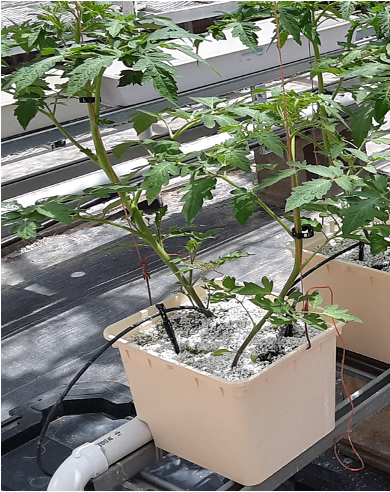
Growing plants using hydroponics may appear as a novel concept, however, hydroponics may play a critical role for increasing availability of fresh fruits and vegetables in high population centers, areas struggling to access fresh produce, or at times when natural resources are limiting. According to AlShrouf (2017), growing plants hydroponically is more complex than growing in a field or garden. However, the system optimizes delivery of key nutrients required by plants using significantly less water than growing in soil. Compared to traditional growing methods, hydroponic systems have a smaller environmental footprint. There is less water loss through evaporation, no leaching or nutrient runoff into nearby bodies of water, and no risks of soil erosion. Environmental impacts are significantly reduced using hydroponics, as various systems are extremely efficient. In comparison to in-ground production systems using irrigation, hydroponics uses less than 10 percent the amount of water, production time is reduced by as much as half, and more than ten times the amount of harvestable product can be grown in the same land area.
Food products consumed fresh, such as greens and small fruits, are typically produced in regions where the naturally occurring environmental conditions are optimal for their production. Harvested product is processed and packaged for shipment to regional distribution centers, where it is then delivered to grocery and food supply vendors. It has been reported that on average the food we eat has traveled as much as 1,500 miles to reach our dinner plate (Harris, 2022). As urban populations increase and lifestyles become heathier, demand for fresh fruits and vegetables have increased. For the U.S., approximately 33 percent of fresh vegetables and 55 percent of fresh fruit (FDA, 2019) are imported from other countries (Table 1), primarily from Mexico and Canada (Davis and Lucier, 2021).
Agricultural production regions are increasingly having difficulties producing crops and assured harvests due to high temperatures, lack of rain, weather extremes and regional climate change (USDA ARS, 2013). As carbon dioxide increases in the atmosphere, air temperatures become warmer, and precipitation becomes more variable. This impacts conventional agriculture systems with variable plant growth and reduced harvests resulting from limited water/irrigation, a reduction in fertilizer and chemical effectiveness, and high temperatures that prevent flower fertilization, critical for fruits to form (Lynch et al, 2020).
The global population increased by a billion people from 2011 to 2022 and has now reached eight billion (Roser et al, 2013). The three most populous countries are China (1.4B), India (1.38B), and the United States (332M) (US Census Bureau). Globally, the amount of tillable (arable) cropland is decreasing due to increased population and urbanization of rural land at a rate faster than the population growth (Bren d’Amour et al, 2016). With increasing populations, less land for cultivation, and the effects of climate change, it is important to increase efficiencies in crop production and introduce innovative production systems.
Fig. B. Example of tomato plants grown in a substrate hydroponics system using perlite. The selected substrate should be inert, provide aeration, drain quickly, and free of insect and disease pathogens.
There are numerous approaches to hydroponics, but all include some type of inert substrate to suspend the plant so roots can contact a nutrient charged water solution. Substrate based systems are those in which plant roots grow within a growing medium, such as gravel, expanded clay aggregate, or perlite (Figure B). Nutrient solutions are irrigated through microtubing emitters placed on top of the substrate and drain through the medium. Solutions can be collected and reused within the system (closed system) or may be allowed to drain away (open system). Solution systems are those in which plants are held by a growing platform and the roots freely hang without medium into deep solutions (Figure C), thin film (Figure D), or nutrient enriched mist (aeroponics). Solution based hydroponics typically are closed systems, making them the most water efficient hydroponic system.
The Kratky passive hydroponics method (Kratky, 2009) is a simple approach in which a deep container is used to hold nutrient solution. Plants are started in small net pots and placed in the top of the container, making sure the roots are in contact with the nutrient solution. As plants grow, the solution level drops and allows a portion of the roots to be exposed to the air while still being able to take up more solution. In theory no nutrient solution replenishment is necessary during the entire crop cycle.
The lunchbox hydroponics activity is like the Kratky technique, however, it is designed so the grower monitors the plants’ progress daily, adding solution as necessary during the crop cycle. Through daily monitoring and engagement, observations can be made on plant development, root growth, and general health. Additionally, activities can be created to count number of leaves, measure size of leaves, or note plant height and root growth. Comparisons can be made between multiple lunchbox hydroponics containers for various treatments, such as using different nutrient formulations, brightness of light, or whether bubbling air into the solution speeds plant growth. To show the benefits of hydroponics to growing in soil, a comparison can be completed between seeds started in a lunchbox hydroponics system to those sown in a container filled with garden soil. Lunchbox hydroponics is a unique project that can be utilized by anyone regardless of age to better understand hydroponics as an innovative plant production system.
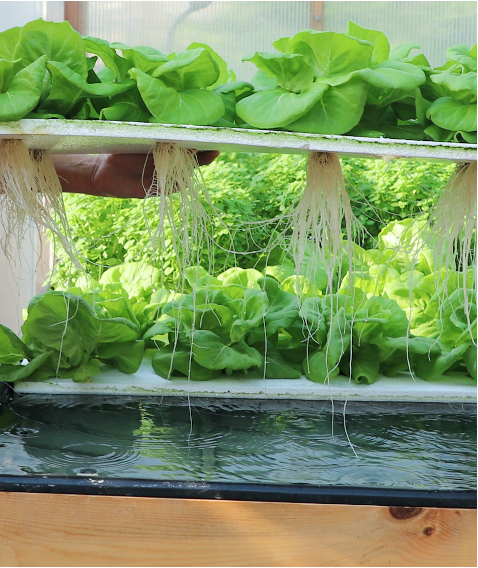

Fig. E. Materials required for construction can be repurposed items from the home and purchased from local retailers, garden centers, or through online resources.
Fig. C. Example of a deep-water culture system (DWC) that uses rafts to suspend lettuce and greens on a hydroponic flood table.

Roots need water and nutrients in an aerobic environment. Complex hydroponic systems have nutrient circulation pumps and oxygenation pumps that introduce air into the solution. For non-recirculating, or passive systems such as in this prototype, roots need to grow within a substrate that provides an interface of the nutrient solution with atmospheric oxygen and gases. In the lunchbox hydroponics system, roots naturally aerate as they permeate the rockwool medium that has drawn nutrient solution up a wicking rope from the reservoir and roots are not fully submerged. The lunchbox system can be constructed, seeds directly sown in the rockwool medium, and system set in a window or under grow lights in as little as thirty minutes. It is recommended to grow bib lettuce for quickest results, but other types of greens or herbs can successfully be grown using this system.
Fig. D. An example of Nutrient Film Technique (NFT) using a two-part channel and snap-top cover that has holes sized appropriately for rockwool plant plugs to be supported over the channel. A thin film (less than ¼” deep) of solution trickles from one end of the channel to the other and is collected in a reservoir for recirculation through the system.
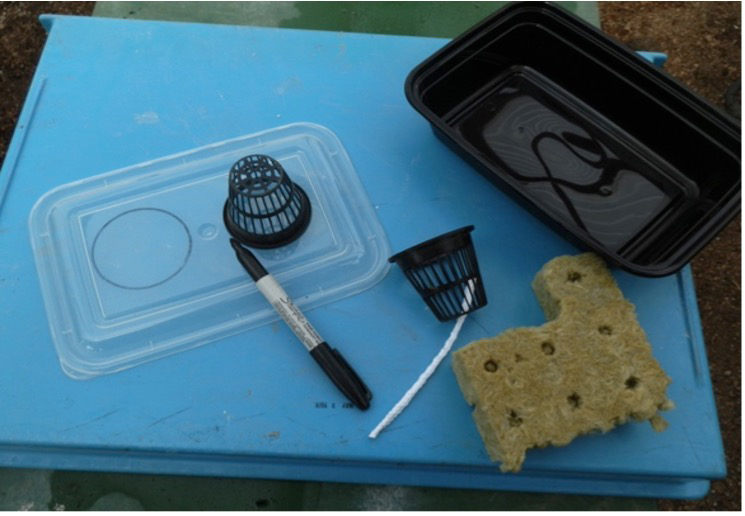
Fig. F. Use inverted pot as the template to determine hole location and size in the meal preparation container.
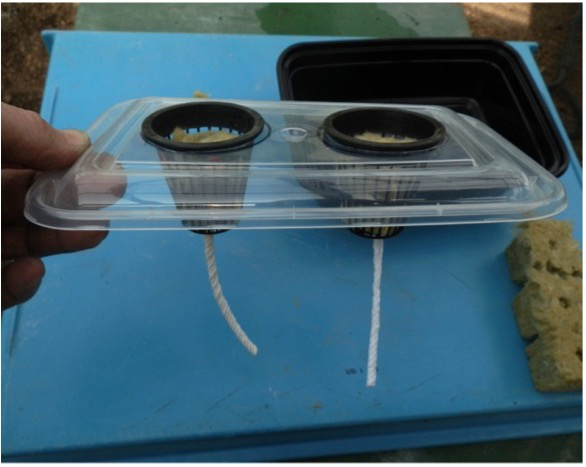
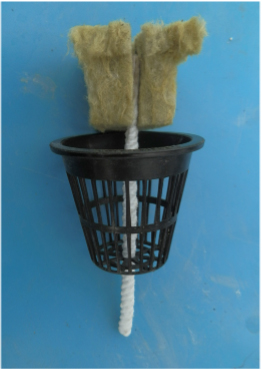
Fig. H. Insert prepared net pots into the lid for placement on the container base filled with nutrient solution.
Items needed to construct the lunch box hydroponic system (Figure E) suitable for two plants include:
Fig. G. Create a solution wick by placing clothesline rope midway through the rockwool fiber and threaded through the bottom of the net pot.
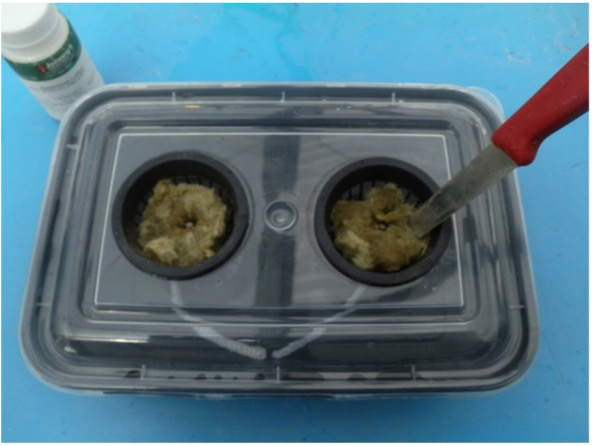
Fig. I. Sow 3-4 seeds of lettuce, greens, or herbs within the top ¼” of the rockwool, gently covering with a bit of loose fiber.

Fig. J. Bib lettuce ready for harvest six weeks following direct sowing of seed in container.
For exploration of hydroponics in this prototype, a simple nutrient solution can be made using a water-soluble plant food that is available at your local garden center. One such product is Miracle-Gro Water Soluble Plant Food for Tomatoes (Scotts Miracle-Gro Corporation, Marysville, OH). The product label indicates it contains 18% N – 18% P – 21% K and several other micronutrients that are important for plant growth. Various hydroponic resources indicate that the target N (nitrogen) level for growing lettuce is between 125 to 150 ppm N. Using the 18-18-21 plant food, the amount of product needed would be between 686 to 844 milligrams per liter of water to reach 125 and 150 ppm N respectively.
Without an accurate way to weigh fertilizer there is the potential for error and resulting concentration may injure plants. One way to circumvent this is to make a concentrated nutrient solution that is diluted later before use. A 10x nutrient concentrate can be approximated by mixing one level tablespoon (~14 grams) of 18-18-21 plant food into two liters of water. When nutrient solution is needed, 1/3 cup (79 ml) of the concentrated solution is then added with 24 fluid ounces (710 ml) of tap water to make a solution that is roughly 125 ppm N. This nutrient solution should only be used for this exploration activity and a more carefully formulated nutrient recipe is recommended for larger projects.
Grow plants in comfortable temperatures that are like that in the home, avoiding drafts from vents and windows. The lunchbox prototype is best grown near a window having bright natural light or under a LED plant grow light. Plants with weak and spindly growth are growing under too low light conditions and need to have more light. Plants with leaves that are bleached out (whitening) or with dried or burned brown spots or have scalding, need to be moved away from the light source. It is important to prevent algae from growing in the nutrient solution by cleaning all containers prior to use, use clean tap or bottled drinking water, and preventing contamination from soil or dirty tools. Algae can be suppressed by excluding light in the nutrient reservoir by either the use of black food grade meal containers or by wrapping the container lid and base with aluminum foil. Use only soluble fertilizers that can be used for vegetable plants as other types can have elements that are not safe for human consumption.
It is rare for insect problems in this system but this can occur if insects are carried in from outdoors. If a pest problem does develop, gently wash the plants in the sink to remove insects. A few drops of mild liquid soap (non-detergent) can be put into water and used as a spray, or organic pest control products can be found at your garden center labeled for your specific use (follow labeled directions).
As we become more aware of climate change, the environmental impacts of conventional farming, food security risks, and an ever-increasing population, consideration of hydroponics may provide one approach to sustainably expand food production. This easy-to-construct hydroponics prototype is suitable for any age to explore growing plants in a truly innovative approach. Especially valuable to teaching STEM in the classroom, the experience of growing plants in a hydroponic system provides opportunity to closely observe plant growth and expand knowledge through questioning.
Table 1. The U.S. vegetable market demand has increased the need for imported produce, primarily supplied by Mexico.
AlShrouf, A. 2017. Hydroponics, Aeroponic and Aquaponic as Compared with Conventional Farming. American Scientific Research journal for Engineering, Technology, and Sciences. ASRJETS 27(1) 247-255.
Bren d’Amour, C., Reitsma, F., Baiocchi, G., Barthel, S., Guneralp, B., Erb, K., Haberl, H., Creutzig, F., and Seto, K. 2016. Future urban land expansion and implications for global croplands. PNAS 114(34)8939-8944. Doi/10.1073/1606036114.
Davis, W. and Lucier, G. 2021. U.S. Fresh Vegetable Imports From Mexico and Canada Continue to Surge. USDA Economic Research Service. www.ers.usda.gov/amber-waves/2021/november/u-s-fresh-vegetable-imports-from-mexico-and-canada-continue-to-surge/ Accessed June 7, 2023.
FDA, 2019. FDA Strategy for the Safety of Imported Food. https://www.fda.gov/food/importing-food-products-united-states/fda-strategy-safety-imported-food
Harris, Linnea. What Are Food Miles? CONNECT4CLIMATE.org. April 27, 2022. www.connect4climate.org/initiative/what-are-food-miles/ Accessed June 7, 2023.
Kratky, B.A. 2009. “Three Non-Circulating Hydroponic Methods for Growing Lettuce”. Acta Horticulturae (843): 65–72. https://doi.org/10.17660/actahortic.2009.843.6
Lynch, J., Cain, M., Frame, D., and Pierrehumbert, R. 2021. Agriculture’s Contribution to Climate Change and Role in Mitigation is Distinct From Predominantly Fossil CO2- Emitting Sectors. Frontiers in Sustainable Food Systems. https://doi.org/10.3389/fsufs.2020.518039
Roser, M., Ritchie, H., Ortiz-Ospina, E., and Rodes-Guirao, L. (2012). World Population Growth. Published online at OurWorldInData.org. Retrieved from: www.ourworldindata.org/world-population-growth. Accessed June 7, 2023.
USDA ARS, 2013. Climate Change and Agriculture in the United States: Effects and Adaptation. Technical Bulletin 1935. http://www.usda.gov/oce/climate_change/effects.htm

This publication has been peer reviewed.
Nebraska Extension publications are available online at http://extensionpubs.unl.edu/.
Extension is a Division of the Institute of Agriculture and Natural Resources at the University of Nebraska–Lincoln cooperating with the Counties and the United States Department of Agriculture.
Nebraska Extension educational programs abide with the nondiscrimination policies of the University of Nebraska–Lincoln and the United States Department of Agriculture.
© 2023, The Board of Regents of the University of Nebraska on behalf of the Nebraska Extension. All rights reserved.